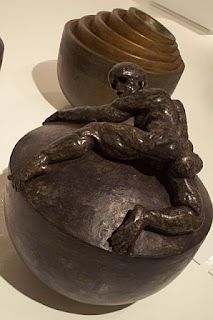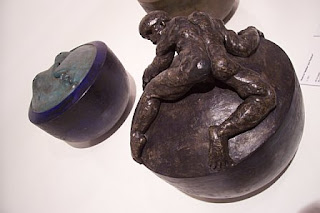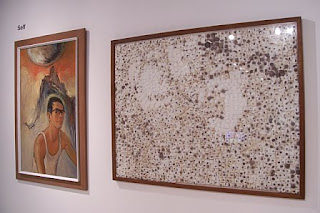This post can be considered as a sequel to one of my earlier posts titled Remembering Ng Eng Teng. As mentioned in the Remembering Ng Eng Teng, the archival display-cum-exhibition Sculpting Life - Ng Eng Teng Collection is now being held at NUS Museum till 31 December 2008. In this exhibition, the exhibits are being presented under three broad sections: Formative Years, Body / Form / Perspectives and Materials / Processes / Public Works.
There are some exhibits at this exhibition which I personally find to be worthy of notice. While I am neither an art historian nor art-critic by profession, it is hoped that this post would give visitors who are novice to Ng Eng Teng's art some ideas of where they could start exploring if they should visit this exhibition.
 Ng Eng Teng, Tension 1972, ciment fondu.
Ng Eng Teng, Tension 1972, ciment fondu.Courtesy of National University of Singapore Museum Collection.
Admittedly, I have been rather influenced by the documentaries that are being shown at the exhibition. After watching them, I was led to realise that Tension, 1972, is a work that has a significant place in Ng Eng Teng's journey to strive to create his own art and yet survive as an artist. Look at the closed-up photo of Tension and one may find that the figurine on this rocker appears as if it would fall any moment. I learnt from the documentaries that this was the effect that Ng Eng Teng was striving to achieve in Tension. As best as I understand, Tension is intended to depict that as one struggles for survival, if one is not careful, one may just slip and fall off.
Putting things into context, Tension was created some years after Ng Eng Teng had returned to Singapore from Ireland. He had worked as a Resident Designer at the Carrigaline Pottery in Ireland from 1964 - 1966. Following his return in 1966, I learnt from one of the documentaries Sculpturing Joo Chiat (1999) that Ng Eng Teng had experienced two years of unemployment. The curriculum of art schools in Singapore back then did not have sculpturing as a core subject for students to study. That meant there was no avenue for Ng Eng Teng to teach the art of sculpture in Singapore back then. In addition, in his early years of establishing himself as an artist in Singapore in the 1960s and early 1970s, it appeared that Ng Eng Teng had met with much challenges and struggles with reality. I remember vaguely the following words that Ng Eng Teng had said in an interview shown in Sculpturing Joo Chiat, "(Tension reminds us of) the importance of keeping oneself sane during hard times". This is one statement that one should be mindful of during difficult moments.
 Ng Eng Teng, Tension 1972, ciment fondu.
Ng Eng Teng, Tension 1972, ciment fondu.Courtesy of National University of Singapore Museum Collection.
Interestingly, Tension was constructed based on the balancing principle of the Kelly doll (similar to the Chinese' 'bu dao weng' 不倒翁). Such a doll is designed to regain equilibrium even when it is tilted at extreme angles. The construction based on such a principle allowed this work to move and rock. I learnt that it was the movement of this work that helps to create the desired sense of tension. Look at the muscles and tendons of the body of the figure in this work, they appear contorted and strained, hence accentuating the sense of tension in this work. The spread-eagle pose of the figure also adds a touch of dramatic tension. Admittedly, I did not feel it was appropriate to touch Tension while I was at the exhibition. Nevertheless, I had managed to see a footage on one of the documentaries of how it would respond like if a viewer were to tilt and rock it. I sensed that it would be pretty tensed experience to be clutching a rocking object for the sake of survival.
Compared to some of Ng Eng Teng's larger iconic sculptures, Tension is much smaller, and visitors may unknowingly miss taking a good look at it. The thing is that do not judge the significance of an art-work merely by its size. Look beyond.
 Tension, together with other exhibits on display.
Tension, together with other exhibits on display.Courtesy of National University of Singapore Museum Collection.
Another exhibit in this exhibition that is worthy for viewers to study and take a good look is The Last Masterpiece.
 On the right: The Last Masterpiece, undated.
On the right: The Last Masterpiece, undated.Courtesy of National University of Singapore Museum Collection.
The Last Masterpiece is one of Ng Eng Teng's last works. If I am not wrong, it was completed with the help of Ng Eng Teng's friends and family. Ng Eng Teng was diagnosed with renal problems in 1995 and this condition was kept a secret. It was only made known to others when Ng Eng Teng had undergone a heart bypass surgery in 1998. The Last Masterpiece is largely made up of cotton swabs. These cotton swabs were collected by Ng Eng Teng himself after his renal dialysis treatment. Do take a close look at this work.
The theme of humanity is one of Ng Eng Teng's favourite subject matters. I like his interpretation of human emotions. Somehow, his works seem to speak with a soul. Look at the work below, Do we look down?. Do you feel as if the figures moved you so much that you wish to offer them a coin or two?
 Ng Eng Teng, Do we look down?, 1968, ciment fondu, paint, lacquer.
Ng Eng Teng, Do we look down?, 1968, ciment fondu, paint, lacquer.Courtesy of National University of Singapore Museum Collection.
Personally, I think Ng Eng Teng had been a very resilient man with a very strong yet humble character. Despite being plagued by poor health, he remained dedicated to his goals of creating his own art. Adversities did not stop him. Even though he was already very weak when he was working on one of his last commissioned works, The Explorer, he persisted to complete it with the help of his family and friends. I learnt from one of the documentaries that despite his ailing state of health, Ng Eng Teng insisted on doing the finishing touches of The Explorer. The Explorer is placed outside the Singapore Art Museum for all to view.
Sculpturing Life - Ng Eng Teng Collection is held at NUS Museum, located at the University Cultural Centre Annex, 50 Kent Ridge Crescent, National University of Singapore, Singapore 119279. The NUS Museum is closed on Mondays and Public Holidays. For more information on the museum's opening hours and on the guided tours, please visit: http://www.nus.edu.sg/museum/information_getting.htm
***
Acknowledgements:
Once again, my heartfelt appreciation to NUS Museum, NUS Centre for the Arts for granting me the permission to take non-flash photography of this exhibition.
Many thanks to Siva for introducing me to staff of NUS Museum.
Thank you to the staff of NUS Museum, NUS Centre for the Arts for arranging for the insightful guided tour to the exhibition on 2 Aug 2008 and for making my visits to the museum enjoyable and educational.
References:
- MediaCorp News. (1999). Sculpturing Joo Chiat. (video)
- MediaCorp News. (2003). Portraits (Episode 6: Ng Eng Teng). (video)
- Sabapathy, T.L. (1998). Ng Eng Teng, art and thoughts. Singapore: NUS Museums, National University of Singapore.
- Singapore Broadcasting Corporation. (1977). Profile of an artist - Ng Eng Teng. Sculptor.
- http://en.wikipedia.org/wiki/Ng_Eng_Teng (Accessed on 9 Aug 2008). (video)

No comments:
Post a Comment